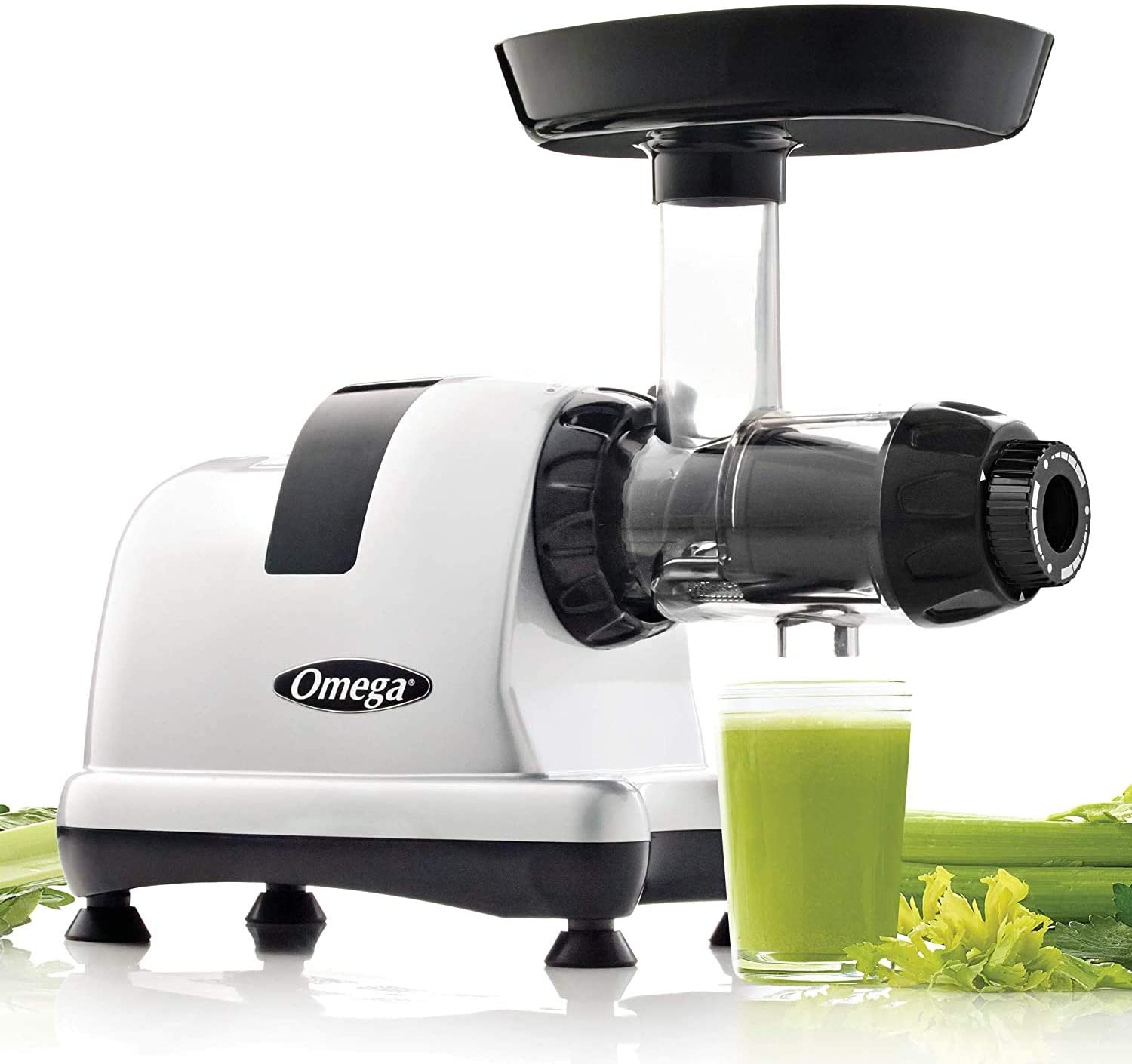This article will debate the merits of a high-powered blender like a Vitamix versus a juicer. By the time we’re done, you should be well on your way to making this important decision. A high-quality blender or juicer does not necessarily come cheap.
Aspects that will be covered are the general pros and cons of Vitamix blenders and juicers, as well as finer points such as extraction, nutrient retention, ease of use and cleaning, and overall versatility.
Well, let’s get right into it!
1. What To Choose? Vitamix Versus Juicer
It’s Vitamix versus juicer in this match-up. So, which one should you choose?
First off, you need to think about what you’re looking for. Whether or not you decide on a Vitamix blender or a juicer should depend on your particular situation.
In essence, a blender uses sharp blades and a powerful motor to, well, blend the ingredients that you place inside. Because everything that goes into the blender stays in the blender, you will retain all the fiber of ingredients such as fruits and vegetables. It will help boost your overall fiber intake, a nutrient in which many people are deficient.
As for juicers, they extract juice from fruits and vegetables. In the process, they remove any fiber and pulp, resulting in a juice that’s lower in fiber but definitely rich in vitamins and minerals. Since juicers extract, they require more of your ingredients to produce a similar quantity as a blender.
Pros And Cons Of Vitamix Blenders
Let’s consider some of the pros and cons of using a Vitamix blender like the Vitamix 5200, which features variable speed control, a large 64-ounce container, the ability to make hot soup, and easy self-cleaning.

Pros
- No fiber-rich pulp is lost, and fiber helps with digestion and elimination and also works to slow digestion, which helps promote more even energy throughout the day.
- Works well for most things, but especially with softer ingredients.
- Some parents find that smoothies are more appealing to their kids.
Cons
- For people who already consume plenty of fiber, the additional fiber retained by a blender may be unnecessary.
- Retains pulp, so will produce a smoothie rather than a juice, which might not be to your preference in terms of texture and taste.
- Some ingredients, for example, root vegetables such as carrots and beets, do not tend to blend well.
- The high rate of speed that a blender’s blades spin at can produce enough heat to kill some of the more beneficial enzymes in your fruits and vegetables.
Pros And Cons Of Cold Press Juicers
Now let’s review some of the pros and cons of using a high-performance juicer like the Omega NC900, which features longer-lasting juices, 5 settings, and surprising versatility.

Pros
- Without the fiber-rich pulp, juices allow for easier digestion plus faster absorption of vitamins and minerals, which results in a quicker energy boost.
- No pulp also means you can pack the benefits from a lot of different fruits and vegetables into one small glass.
- Great at handling harder ingredients like the aforementioned root vegetables.
- There is less heat damage with juicers, as some blenders’ blades run so fast that the heat they produce damages beneficial enzymes.
Cons
- Juicing machines are often much more difficult to clean, given that they feature more parts.
- Since juicing does not produce as much for the same ingredients as a blender, you need more space to store all the produce.
- This same reason also means that you will be spending more money on produce.
- Some ingredients, such as whole leafy greens, are simply more nutritious whole. By removing the skin and insoluble fiber, the fruits and vegetables become somewhat less nutritious.
2.Comparison Of Features – Vitamix Versus Juicer
Extraction
As outlined above, it’s important to consider the aspect of what is retained through the blending or juicing process—after all, most of us decide to get a blender or juicer for health reasons.
Whereas blenders can subtly reduce health benefits through the heat that they produce in the blending process, they are generally healthier than juicers for the simple reason that they retain more fiber. As mentioned, studies show that the majority of Americans are deficient in this hyper-important nutrient.
Juicing, however, provides a quick dose of vitamins and minerals and may be suitable for people who already get plenty of fiber in their diet. The removal of pulp creates for a more concentrated beverage and thus more “bang for your buck”—so to speak, as the amount of produce you have to buy costs more to produce the same amount as when blending.
Ease Of Use
Well, what about Vitamix versus juicer in terms of ease of use and ease of cleaning? After all, most of us live busy lives and don’t want to lose an hour of our day to make our smoothie or juice and clean it up.
For ease of use, both a Vitamix and a top-of-the-line juicer are very simple to use, with a bit more of a learning curve for juicers as they feature more parts.
Another aspect impacting ease-of-use is the amount of prep work needed. Whereas ingredients can be left pretty large before getting thrown in a standard blender, they typically need to be cut into much smaller pieces to fit into a juicer’s small chute.
As for cleaning, there’s also a clear winner here, as the Vitamix blender is so powerful that by simply adding some warm water and soap, you can run it and quickly clean your blender after most uses. This, and the fact that blenders feature fewer parts, would give blenders an edge in this category.
Although some companies have made an effort to minimize the cleaning time that accompanies their juicers, they still contain more parts and will thus require more maintenance over time. Notably, while the Vitamix advertises how easy it is to clean, the Omega juicer does not.
Reviews of the Omega, however, claim that it makes for easy clean-up, with just a quick rinse being all that’s needed for most of its parts, particularly if taken care of immediately after juicing.
Another aspect to consider here is your kitchen/counter space. Blenders are more compact and thus take up less space, meaning that you’re more likely to have room for it on the counter where you’ll see it and be reminded to make a delicious smoothie. Juicers, on the other hand, are bulkier and less likely to find a home on your kitchen counter.
Versatility
Blenders are inherently more versatile than juicers. At least, that’s what it seems like on the surface. After all, you can put just about anything in a blender.
Although they’re best known for making smoothies, Vitamix touts that you can also use them for hot soups, baby food, nut butters, batters, dressings and sauces, non-dairy milks, dips and spreads, and even flours and dough.
As for the Omega NC900, it features an impressive list of capabilities as well, especially considering the fact that most juicers are thought of as one-trick ponies. A multi-tasking unit, the Omega juicer can also whip up nut milks, grind down spices, create frozen fruit desserts, and even extrude pasta.
These extra functions, however, do require swapping out components and do increase the overall time spent using and cleaning the machine.
3. Final Conclusion

So, Vitamix versus juicer—which is it?
Unfortunately, it doesn’t make any sense for me to give a one-size-fits-all answer. My needs will be different from yours, which will be different from your neighbor’s. Just make sure to consider the pros and cons of both, and which works better with what you’re looking for.
That said, I’ll give you my own opinion: if I had to pick only one, I would likely opt for the Vitamix. Here’s why.
While both a Vitamix blender and a high-quality juicer like the Omega are versatile, blenders tend to offer a bit more versatility and with more ease. Overall, the Vitamix appeals to me more thanks to its ease of use and ease of cleaning. They produce more for what you put into them and retain more fiber.
As a time- and health-conscious person, I want to minimize my time spent in the kitchen where I can. I also live in an apartment and don’t have endless kitchen/counter space. The Vitamix simply makes the most sense for my situation.
That said, take your time and consider what works best for you. The following factors will help you decide:
- Do you prefer drinking smoothies or juice?
- If you prefer the former, go for a blender; if you prefer the latter, opt for a juicer.
- Does your diet already contain ample fiber?
- Then you’re probably fine to forego the fiber that’s preserved by blenders.
- Will you be making things for your whole family?
- You can save time with a blender and kids might also find smoothies more appealing than juicer
- Are you already pressed (no pun intended) for time?
- Blenders tend to save you more time overall.
- Do you hate cleaning up?
- Blenders tend to take less clean-up time overall.
- Do you want to be able to make the largest variety of things?
- Then blenders also have an edge here.
But hey, if you can afford both (and have the space for both), then more power to you! No matter what you choose, make sure you understand that a Vitamix or juicer is a long-term investment in your health, so you don’t want to skimp out on your budget to the extent possible.
Whichever you choose, happy blending or juicing!

Recent Comments